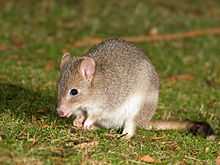Eastern bettong
| Eastern bettong[1] | |
|---|---|
 | |
| Conservation status | |
| Scientific classification | |
| Kingdom: | Animalia |
| Phylum: | Chordata |
| Class: | Mammalia |
| Infraclass: | Marsupialia |
| Order: | Diprotodontia |
| Family: | Potoroidae |
| Genus: | Bettongia |
| Species: | B. gaimardi |
| Binomial name | |
| Bettongia gaimardi (Desmarest, 1822) | |
| Subspecies | |
|
Bettongia gaimardi cuniculus | |
 | |
| Present distribution of Bettongia gaimardi | |
The eastern bettong (Bettongia gaimardi), also known as the southern bettong and Tasmanian bettong, is a bettong whose natural range includes southeastern Australia and eastern Tasmania.[1][3]
Subspecies
Two formerly recognised species, Bettongia cuniculus (Tasmanian bettong) and Bettongia gaimardi (eastern bettong), were placed into a single species with two subspecies by Wakefield in 1967:[4][5]
- B. g. gaimardi, mainland subspecies (now extinct)
- B. g. cuniculus, Tasmanian subspecies
The introduction of the red fox and European rabbit to Australia led to the extinction of the mainland subspecies during the 1920s.[2][5] The Tasmanian subspecies still exists.[2] In 2012, a small population was reintroduced to the mainland in Canberra, where they appear to be doing well.[6]
Diet and behaviour
This bettong's habitat is open woodlands at altitudes between sea level and 1,000 m. (The highest point on Tasmania is at 1,617 m.) The bettong usually nests in dry, open eucalypt forests and grassy woodlands. It is a nocturnal animal, sleeping during the day in a domed, grass nest that serves as camouflaged. Bettongs build their nests with grasses and leaves, which they transport to the nest using its curved prehensile tail.[7]
A major component of their diet is underground fungi related to truffles, but it digs up roots and tubers as well. Insects and grubs are also eaten when encountered. It is unique in that it will travel up to 1.5 km from its nest to a feeding area, a considerable distance for such a small creature.[7]
Like other bettongs, the eastern bettong is a continuous breeder with a gestation period of only three weeks. Bettongs produce young all year.[8]
Threats
While the mainland population became extinct in the 1920s,[2][5] the Tasmanian population has remained secure.[2] One concern is that most of the bettongs are found on private land, with only two groups found within reserves. Red foxes are a major threat.[9][10] The International Union for the Conservation of Nature has raised the threat status for eastern bettongs from least concern to near threatened.[2]
References
- ↑ 1.0 1.1 Groves, C. P. (2005). Wilson, D. E.; Reeder, D. M, eds. Mammal Species of the World (3rd ed.). Baltimore: Johns Hopkins University Press. p. 57. OCLC 62265494. ISBN 0-801-88221-4.
- ↑ 2.0 2.1 2.2 2.3 2.4 2.5 Menkhorst, P. (2008). Bettongia gaimardi. In: IUCN 2008. IUCN Red List of Threatened Species. Retrieved 29 December 2008. Database entry includes justification for why this species is listed as near threatened
- ↑ Rose, R. (1997). Metabolic rate and thermal conductance in a mycophagous marsupial, Bettongia gaimardi. The World Wide Web Journal of Biology 2: 2-7.
- ↑ Wakefield, N. (1967). Some taxonomic revision in the Australian marsupial genus Bettongia, with description of a new species. The Victorian Naturalist. 84:8-22.
- ↑ 5.0 5.1 5.2 Department of Sustainability, Environment, Water, Population and Communities (2011). Bettongia gaimardi gaimardi in Species Profile and Threats Database, Department of Sustainability, Environment, Water, Population and Communities, Canberra. Available from: http://www.environment.gov.au/sprat. Accessed Thu, 29 Dec 2011 06:51:31 +1100. (http://www.environment.gov.au/cgi-bin/sprat/public/publicspecies.pl?taxon_id=66656)
- ↑ ABC News Rare marsupials found fat and happy in new home http://www.abc.net.au/news/2013-01-20/marsupials-found-fat-and-happy-in-their-new-home/4472690
- ↑ 7.0 7.1 Department of Primary Industries and Water (August 2006). The Tasmanian bettong]. Department of Primary Industries and Water.
- ↑ University of Tasmania, School of Zoology. Profile – Tasmanian Bettong]. University of Tasmania.
- ↑ Department of Primary Industries and Water - Foxes in Tasmania http://www.dpiw.tas.gov.au/inter.nsf/ThemeNodes/LBUN-5K438G
- ↑ Foxes in Tasmania-Invasive Animals CRC Report http://www.dpiw.tas.gov.au/inter.nsf/publications/lbun-6r26gg?
